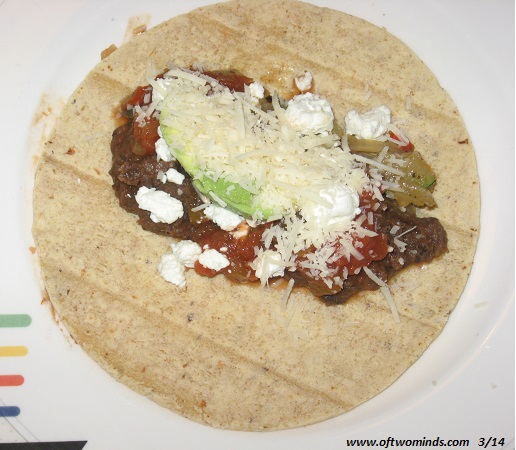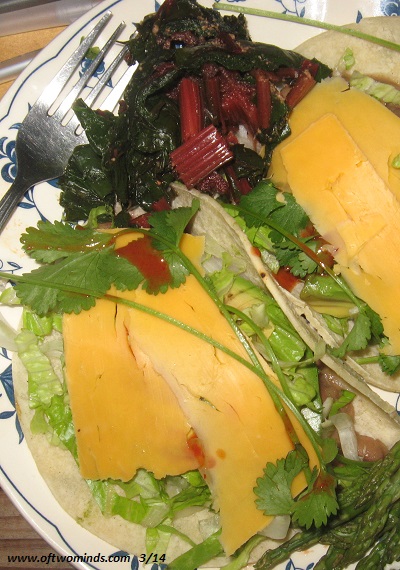How to Build Bone Mass (Tacos)
Impact exercises like jumping and running build bone mass.
I don't mean to suggest eating tacos builds bone mass--these are simply the two (unrelated) topics of this weekend's post.
What does build bone mass is impact exercises like jumping and running. This was explained in two recent articles from the New York Times (registration required):
Exercises to Strengthen Bones
High-Impact Exercise Is Good for Your Bones
Maintaining bone mass is important as we age. Studies are finding that weightlifting and non-impact exercising like biking and swimming don't add bone mass, despite their many other health benefits.
Hopping helps:
In general, activities that involve impacts with the earth, such as running and jumping, are the most effective way to improve bone health, according to Dr. Jon Tobias, a professor of rheumatology at the University of Bristol who studies bone health. They create ground-reaction forces that move through your bones and stimulate them to “remodel” themselves and add density, he said. They also entail strong muscular contractions that tug at and slightly bend attached bones, redoubling the stimulating effects of the exercise.
Sprinting and hopping are the most obvious and well-studied examples of high-impact exercises. In one recent study, women ages 25 to 50 who leaped like fleas at least 10 times in a row, twice per day for four months, significantly increased the density of their hipbones. In another, more elaborate experiment from 2006, women who hopped and also lifted weights improved the density of their spines by about 2 percent compared to a control group, especially if the weight training targeted both the upper body and the legs. Women whose weight training focused only on the legs did not gain as much density in their spines.Those who need to build bone mass most might not be up to impact exercises:
So, Dr. Tobias says, young people and healthy adults should probably pound the ground, at least sometimes. Sprint. Jump off a box 15 inches or higher at your gym and jump back up. Hop in place. A study by other researchers published in January found that women between 25 and 50 who hopped at least 10 times twice a day, with 30 seconds between each hop, significantly increased their hipbone density after four months. Another group of subjects, who hopped 20 times daily, showed even greater gains.
Alas, a kind of Catch-22 confronts older individuals who have not been engaging in high-impact exercise: Their bodies and bones may not be capable of handling the types of activity most likely to improve bone health.This suggests starting impact exercises before bone loss becomes an issue. The articles don't mention jumping jacks, a staple of physical education classes, but I reckon that sort of low-impact routine would work for those fit for that sort of exercise (and be sure to get checked out before starting any new fitness regime).
Though none of the studies cited mention hitting a heavy punching bag, I would guess martial-arts-type punching and kicking activity would count as impact exercise.
OK, on to tacos. When the 12-hour days pile and and we're exhausted, tacos offer a quick homemade meal for a few nights. Cook up a pot of Mexican-style beans (a pressure cooker helps speed the process considerably) on Sunday and the leftovers can be heated as needed. (Cocina De La Familia: More Than 200 Authentic Recipes from Mexican-American Home Kitchens is a good source for Mexican-style recipes.)
The great thing about tacos is the flexibility of the ingredients; they're especially easy for vegetarians and those avoiding gluten, as corn tortillas are the foundation. Possible toppings include lettuce, avocado, leftover steamed veggies, red and green peppers, tomatoes, salsa, sriracha sauce, cilantro, flavored firm tofu, any type of cheese you favor--the list is long indeed.
Tacos can be elaborate or simple, a meal for guests or one tossed together in a state of famished exhaustion.
Here's a taco composed of beans, stir-fried zucchini and onions, avocado, salsa and feta and parmesan cheeses:

Here's a taco meal assembled in a few minutes at the end of a crazy-long day. The tacos are just beans, avocado, lettuce, cilantro, sriracha and some thinly sliced sharp cheddar. The two vegetables are also quick: steamed asparagus and chard from the garden which was leftover from the previous evening: From the Garden to the Table in 20 Minutes (February 22, 2014)

Not only is it easier to eat at home at the end of an exhausting day (if you have some leftovers and corn tortillas), it's healthier and tastes better, too.
"A healthy homecooked family meal and a home garden are revolutionary acts."
The Nearly Free University and The Emerging Economy:
The Revolution in Higher Education
Reconnecting higher education, livelihoods and the economyWith the soaring cost of higher education, has the value a college degree been turned upside down? College tuition and fees are up 1000% since 1980. Half of all recent college graduates are jobless or underemployed, revealing a deep disconnect between higher education and the job market.
It is no surprise everyone is asking: Where is the return on investment? Is the assumption that higher education returns greater prosperity no longer true? And if this is the case, how does this impact you, your children and grandchildren?

We must thoroughly understand the twin revolutions now fundamentally changing our world: The true cost of higher education and an economy that seems to re-shape itself minute to minute.
The Nearly Free University and the Emerging Economy clearly describes the underlying dynamics at work - and, more importantly, lays out a new low-cost model for higher education: how digital technology is enabling a revolution in higher education that dramatically lowers costs while expanding the opportunities for students of all ages.
The Nearly Free University and the Emerging Economy provides clarity and optimism in a period of the greatest change our educational systems and society have seen, and offers everyone the tools needed to prosper in the Emerging Economy.
Read Chapter 1/Table of Contents
print ($20) Kindle ($9.95)
Things are falling apart--that is obvious. But why are they falling apart? The reasons are complex and global. Our economy and society have structural problems that cannot be solved by adding debt to debt. We are becoming poorer, not just from financial over-reach, but from fundamental forces that are not easy to identify. We will cover the five core reasons why things are falling apart:
 1. Debt and financialization
1. Debt and financialization2. Crony capitalism
3. Diminishing returns
4. Centralization
5. Technological, financial and demographic changes in our economyComplex systems weakened by diminishing returns collapse under their own weight and are replaced by systems that are simpler, faster and affordable. If we cling to the old ways, our system will disintegrate. If we want sustainable prosperity rather than collapse, we must embrace a new model that is Decentralized, Adaptive, Transparent and Accountable (DATA).
We are not powerless. Once we accept responsibility, we become powerful.
Read the Introduction/Table of ContentsKindle: $9.95 print: $24
| Thank you, New Terra Farm ($5/month), for your superbly generous subscription to this site -- I am greatly honored by your support and readership. | Thank you, James W. ($5/month), for your splendidly generous subscription to this site -- I am greatly honored by your support and readership. |



























